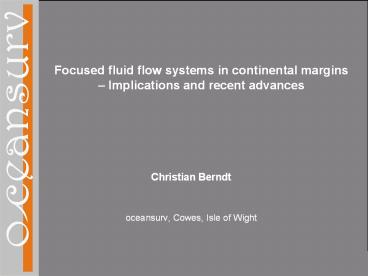Focused fluid flow systems in continental margins - PowerPoint PPT Presentation
Title:
Focused fluid flow systems in continental margins
Description:
Scientific targets and hydrocarbon industry relevance. Focused fluid flow systems ... Implications and recent advances ... Methane hydrate (clathrate) ... – PowerPoint PPT presentation
Number of Views:73
Avg rating:3.0/5.0
Title: Focused fluid flow systems in continental margins
1
Focused fluid flow systems in continental margins
Implications and recent advances
- Christian Berndt
- oceansurv, Cowes, Isle of Wight
2
Overview
- Introduction
- Focused fluid flow systems
- Relevance of focused fluid flow systems
- Seismic imaging
- Gas hydrates
- Volcanic intrusions
- Geohazards
- High-resolution 3D seismic acquistion system
- Conclusions, outlook and possibilities for
collaboration
3
Fluid flow in passive margins
Berndt, 2005
4
Why fluid flow research?
- Fluid flow is the most important link from the
subsurface to the seabed and many seabed
processes cannot be understood without this link - Fluid flow/seepage and sedimentation are the two
most important carbon fluxes from/to the
geosphere - Fluid flow has important implications for
hydrocarbon exploration and production, but it is
only understood for very simple cases - Fluid flow is highly relevant to society on a
short term as opposed to many other geological
processes
5
Specific fields of research
Fluid flow in passive margins is an important
aspect of the Earth System
- Fluid flow controls the release of carbon into
the ocean and into the atmosphere - Fluid flow provides nutrients for chemosynthetic
ecosystems - Fluids and gas migration poses the most dangerous
hazard to offshore exploration and scientific
ocean drilling - Fluid flow controls the distribution of natural
energy resources (oil, gas, condensates, gas
hydrates)
Weaver et al., 2004
6
What does seafloor methane hydrate look like?
- Methane hydrate (clathrate)
- Methane (CH4) gas molecule trapped in lattice of
water (H20) molecules - Dissociates (solid ? gas)
- High P, low T
Pictures IfM-Geomar
7
Where do we find methane hydrates?
Berndt et al. 2003
8
Geophysical response to gas hydrates
- Gas hydrate quantification through
- Seismic velocity response
- Seismic attenuation
- EM
High Q low Q-1
Western Svalbard Hydratech OBS tomography
results, Rossi et al. (2007)
9
Evidence for gas hydrates
Vanneste et al., 2006
10
Intrusive volcanism in sedimentary basins
- Break-up related volcanism
- Sill intrusions into the sedimentary basins
- Contact metamorphism releasing huge amount of
carbon into the atmosphere - Early Eocene climate optimum
Explosive eruption of greenhouse gas
Formation of pipes and explosion craters
Svensen et al. 2005
11
Distribution of vent complexes on the Norwegian
Margin
- 735 mapped
- 2-3000 likely present
- 1-2 km below the sea floor
Mud volcanism in Azerbaijan as a modern analogue
to gas explosions? (Photo BBC, 2001)
Svensen et al., 2004
12
Volcanic intrusions in the Faeroe Shetland Basin
Vents in the Faeroe Shetland Trough
Berndt and Hili, 2006
13
Free gas and slope stability linkage
Masson and Berndt , 2006
14
Blow outs from free gas accumulations A major
geohazard
- Gas blow-outs are the single biggest geohazard
for the offshore industry - Every year blow-outs happen causing casualties
- 3D imaging of shallow gas accumulations is
necessary for avoiding blow-outs
15
P-Cable projects
- P-Cable is patented technology by VBPR
- Joint development project involving VBPR, NOCS,
UTromsoe, and IfM-Geomar
- A seismic cable towed perpendicular to the
vessels steaming direction - Many single-channel seismic streamers attached to
a wire held in place by two doors
16
Mercator Mud Volcano Gulf of Cadiz
BSR
Berndt et al., 2007
17
3D visualisation
Berndt et al., 2007
18
Overview
- Introduction
- Focused fluid flow systems
- Relevance of focused fluid flow systems
- Seismic imaging
- Gas hydrates
- Volcanic intrusions
- Geohazards
- High-resolution 3D seismic acquistion system
- Conclusions, outlook and possibilities for
collaboration
19
Summary
- Focused fluid flow systems are extremely relevant
to society as they control our environment in the
short term - Understanding the involved physical processes is
instrumental for assessing their role in - climate change
- chemosynthetic ecosystems
- distribution of energy sources
- geohazards (tsunamis, slides, etc.)
20
Possible Collaborations
- Influence of halokinesis on fluid migration
patterns / cementation and drilling problems
around salt diapirs - Effects of fluid migration/gas hydrates on sea
bed stability - Mud volcanoes as a window to deeper hydrocarbon
systems - Thermal structure from BSR depth
- Effect of sill intrusions on sedimentary basins
- Carbon sequestration
- Site surveys
21
Contact details
Dr. Christian Berndt oceansurv 32 Denmark
Road Cowes Isle of Wight PO31 7SZ United
Kingdom cbe_at_noc.soton.ac.uk
Consulting projects will be carried out by
oceansurv. Scientific projects will be carried
out either through National Oceanography Centre,
Southampton, or IfM-Geomar, Kiel depending on
project.































